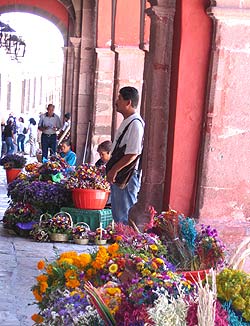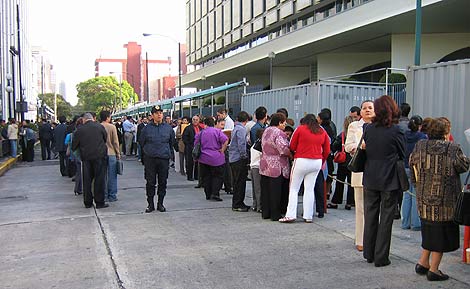MEXICO CITY — I have something of a double or triple life. I guess all of us who call the States home but work in another country do. For me, the real duplicity comes not just from being an American working in Mexico, but from having to maneuver among private and public agencies, academic institutions, and non-governmental organizations collecting information from collaborators and competitors without arousing suspicion.
 Had an interesting summer? We're looking for students to share their summer research or internship experiences for a special edition of Student Journal. Whether you've been studying mambo kings in Cuba or the plight of refugees in the Congo, if you've got a story to tell and pictures to illustrate it, e-mail us for more information. We'll select three to five students to write a one-time-only dispatch for publication mid-August. |
I don't feel like I'm being deceitful or anything like that; I truly want to get information from all of these groups and to process it in an unbiased fashion so that I can form the clearest picture of what's going on here. It's just that.sometimes I don't know where I fit, what information to trust, if I am unknowingly creating alliances or worse, burning bridges. I hop between stately buildings, I "make myself comfortable" on lush leather couches as directed. I wear lipstick.
And that's just the half of it. Here in Mexico City, I've been investigating the policies that inadvertently or directly push international migration. Further, I've been identifying other policies that now try to put "remittances" (that's the technical term for U.S. dollars that migrants send back to their communities in Mexico), to good use by applying them to projects that encourage community development. I haven't even yet begun to explore the human side of these two different, but closely related, policy bodies. I'm just now starting to talk to the people who each of the groups I have interviewed so far has been working to regulate, exploit, save, or study. How will my chameleon colors change when I leave the city tomorrow and make contact with my "subject population," in this case migrants as well as the families and communities they've left behind?
How is it that I, a young woman with little real work experience and a growing, but still quite modest, knowledge of the factors that impact my study, am able to have access to both sides of the spectrum - the big organizations and the little people at the end of the chain? OK, I've got a few things working for me: I'm white, empowered, educated, have a little bit of change jingling in my pockets, and I have a business card that affiliates me with the University of California, Berkeley. That business card is key; I swear, it's like gold. It's simply a matter of privilege and connections.
 Flower sellers hawk their colorful wares in San Miguel de Allende, a picturesque colonial city in Central Mexico. |
Daily, my mind is barraged with hesitations and doubts. Like all researchers, I am constantly questioning why, and if, I have the right to snoop around asking questions. Should I be crossing all of the social, political and economic lines that have traditionally separated the players I'm trying to understand? Am I taking the right steps? Talking to the right people? Putting the pieces together in ways that fit? Will my results be accurate and representative portraits of the people and places I'm observing? Will my work make the situation and society as a whole better? Am I the right person to make all of those things happen?
Recently I had an interview that turned into more of a discussion and exchange of ideas (as many often do). My interviewee, a white American man with an elite academic background who is now at the top of the chain in an international foundation, helped put my mind at ease. I was expressing my concern about being 'just another graduate student' who had left my own country to observe, study and pass judgment, and eventually, to speak authoritatively about an unfamiliar place. Looking at me earnestly, he pointed out that because my work is on globalization, how can I, as researcher, limit myself to my own country? I am studying global changes, universal processes and forces, and international people - all of which actively defy the natural and historical borders constructed by traditional politics. "They don't respect borders," he stated, "why should you?"
And with those words of advice, onward.
I'm shuffling from interview to interview, always getting ready for the next and simultaneously trying to process what happened in the last. Plus, I've got to keep up on the new studies, books and policy analyses that I'm collecting at an alarming rate. Already, all of my ideas and initial hunches have reformulated themselves.
To recap: What am I trying to understand? In the most boiled-down sense, I am trying to figure out how the remittance dollars sent home to Mexico from the United States by migrants are being used for economic development. Add the factors that drive migration in the first place, the human-rights abuses that migrants endure along the way and the changes in the social and economic structures of the communities left behind, and the questions become pretty big. OK, not just big, but gigantic.
To get results in the short amount of time I have here, I've been working hard to narrow the project to study one or two ways that migration is related to economic development. I've decided to focus on the ways that remittance dollars are being 'formally' channeled into the economy. That is, rather than looking at how individual households use the remittances sent to them by their family members, I'm zeroing in on projects sponsored by the government and private or community organizations that are using remittance dollars to create new jobs, or roads, or schools that will be enjoyed by the community as a whole. Mostly, the way this works is that migrants from the same community in Mexico join together in groups in the United States, called Home Town Associations (HTAs), and pool their resources to raise funds for a particular project that community members at home have requested. The projects can then go forward with just these resources, or the HTAs may team up with the government or private companies to raise more money for bigger projects. But in either case, the migrants are probably not only donating money to these projects, but more than likely are also sending a monthly sum home to their own family to support day-to-day living needs.
Sounds like a pretty finite, definable focus for me, right? That's what I thought. But alas, as I started looking into the two or three projects that I knew about, more projects kept popping up. Some are run by the government, some by communities, some by individual migrants in the United States, and still more by international development agencies and private organizations that specialize in microcredit lending and banking. The projects are supposed to help offer social services and form new businesses that will generate jobs and incomes for those left behind in communities with failing economies. As the number of players involved in the creation of the projects increases, however, it seems less and less clear who actually benefits in the end and what the ultimate goals are. To make it worse, as I began doing interviews to decipher all of the projects, I found that each project operates in a complete vacuum, fully separate from all of the others. Often, goals of one project seem to be in direct conflict with another, sometimes this is the case even between different projects operated by the same organization.
As I leave Mexico City and the policy world to see how the projects play out on the ground, the formal and institutional take on how remittances can and should be used for development is about as clear as mud. So far, I've identified three main groups of projects that use remittance dollars to affect economic development:






